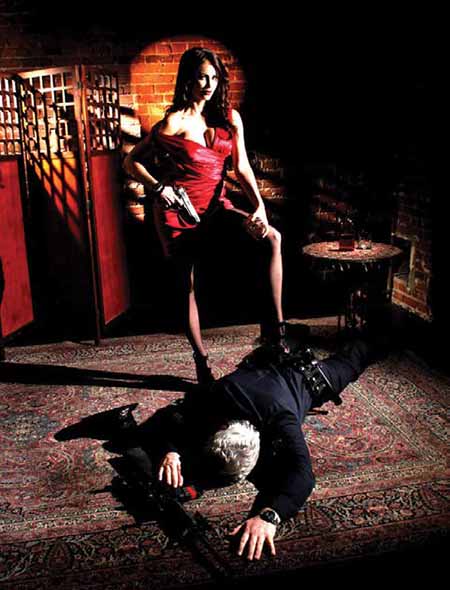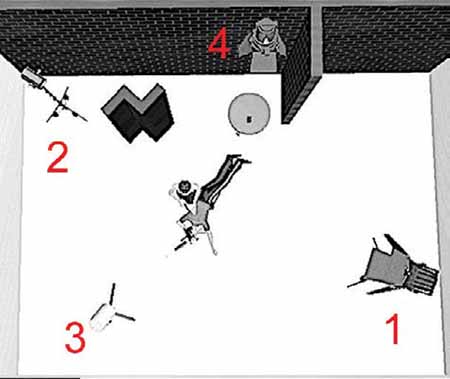An Exercise in Vintage Hard Light

Jay Holben
I was reminded of this particular project recently while posting some tips on Instagram. In the not-too-distant past, I was the second unit director and director of photography on an HBO/Cinemax series called “Femme Fatales.” I was also employed to produce, direct and photograph the opening title sequence for the series.

Fig. 1: The original photograph that appeared in LIFE magazine was a parody of the Hays Code “no-nos.” Mark Altman, the show’s co-creator, had some specific concepts for the titles, one of them being a recreation of a photograph, shot for Life Magazine in the 1940s. The photograph (Fig. 1), was a parody of all the things you can’t show in a film because of the “Hays Code”—the precursor to the current movie ratings system. Altman wanted this classic image to be part of the introduction to the show and it was my job to reenvision the photograph with the show’s host, Tanit Phoenix.
Looking at the original photograph, I quickly noted that it was going to be an exercise in hard lighting. The things that stood out to me, first, were the hard sidelight and the great bright spot on the wall behind the model that provided some beautiful separation.
Having come from a theatrical lighting background before working in film, I’m no freshman when it comes to working with hard light. In fact, in spite of modern photographic trends, I find that hard light can be truly beautiful, when used correctly—and I often like to use hard light with women and fashion photography, which would also seem to buck modern trends.

Fig. 2: My lighting setup: 1) 2K Fresnel at full flood; 2) 1K Fresnel through screen; 3) 575 W Source Four Leko projecting circle of separation light; 4) 150 W Fresnel above small table. It was decided I would be shooting alongside first unit to grab Phoenix between her shooting, and I would be forced to find a space within the location to shoot, away from main unit. This kind of redheaded stepchild treatment is common for second/additional unit, so it was something I was used to.
I ended up choosing a dark corner of the location that had exposed brick. There was, unfortunately, an exposed power panel on the wall, so I brought in a folding privacy screen to cover that eyesore.
The professional video industry's #1 source for news, trends and product and tech information. Sign up below.
I was working closely with co-executive producer David Williams on the title sequence and he volunteered to play the ill-fated police officer under Phoenix’s foot in the shot.
For lighting, I started with a 2K Fresnel, set at full flood, and backed off to give me the hot sidelight that would cover all of Phoenix and Williams on the ground. I decided to keep this very contrast-y and not employ any fill, letting the shadow side fall to deep black.
Next up was a 575 W Source Four Leko that I brought in to put the separation light behind Phoenix’s head. The original photograph had a somewhat more amorphous shape to the separation light, but that didn’t really play very well on the exposed brick. I preferred to have a solid, tight circle.
Next up, the privacy screen was dropping too deep in the shadow. I wasn’t really happy with this lifeless dark corner, so I brought in a 1K Fresnel and backlit the screen to put some light through the holes and give me some life and texture in that back corner.
Finally, to spotlight the whiskey bottle on the table, I brought in a 150 W Arri Fresnel and spotted it in over the table to provide a little round hotspot that didn’t spill off too much on to the floor.
There was no diffusion, no bouncing; all very hard light used to create this moment.

Fig. 3: A still of the final composition that was used for marketing purposes, showing the entire setup. Most of the time, shooting additional photography and second unit, you’re pressed for time, equipment, resources and crew. Over the years, I’ve become very comfortable with these limitations and this shoot was no exception. It was, by design, both creatively and artistically, that I kept it to a minimum of lighting fixtures and hardware that I could handle on my own and be ready to shoot at a moment’s notice when Phoenix was free from main unit photography (Fig, 2).
The final shot used in the titles was a tip-up and the editors cut off Williams as the dead officer (Fig. 3). Several stills that I shot that night were used in marketing for the series. All in all, an eventual and memorable night and a great exercise in the beauty of hard light.
Jay Holben is the author of the book “A Shot in the Dark: A Creative DIY Guide to Digital Video Lighting on (Almost) No Budget.”
